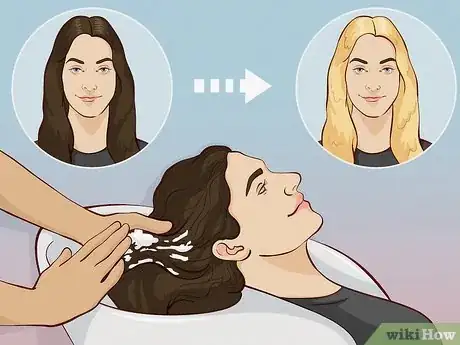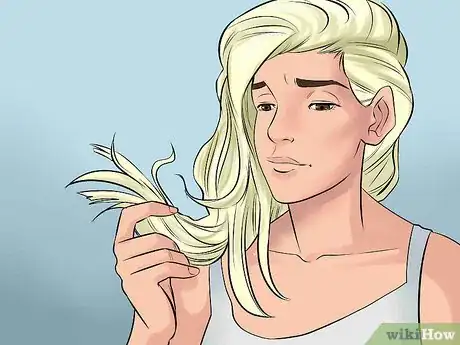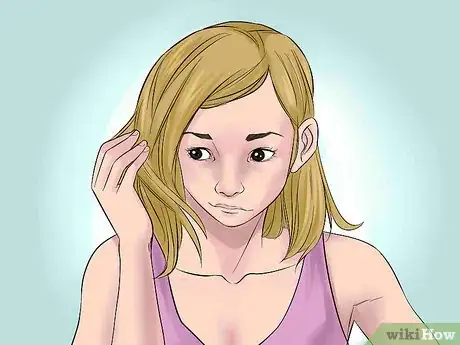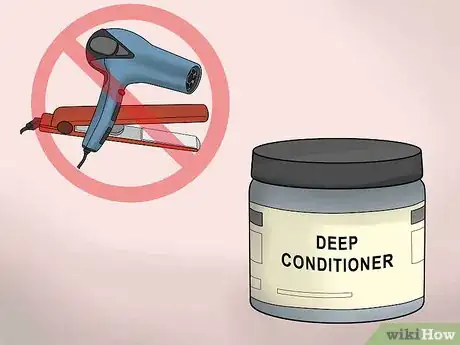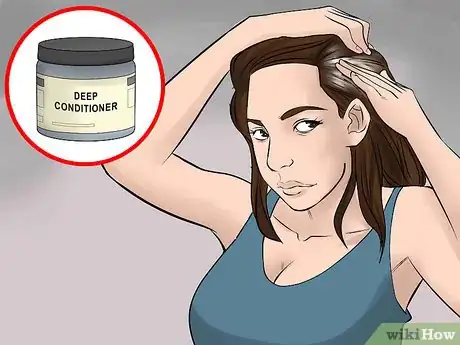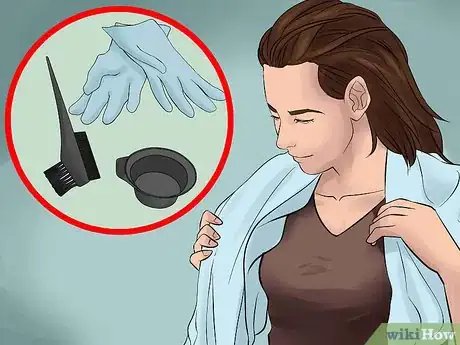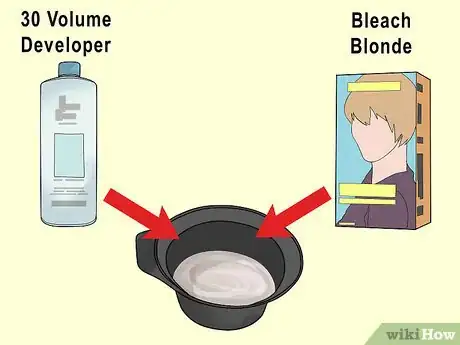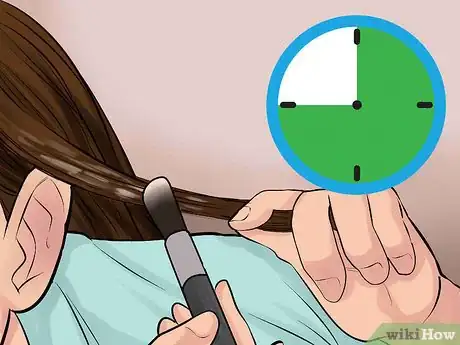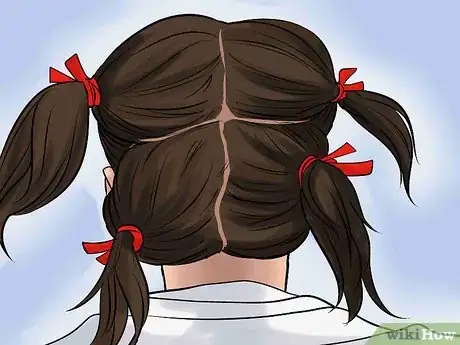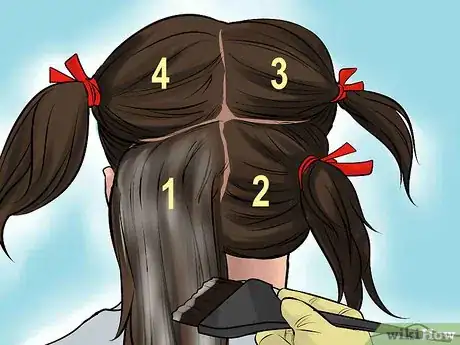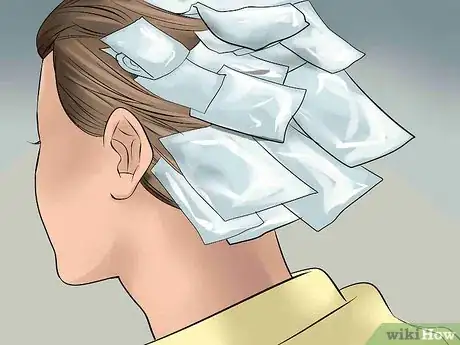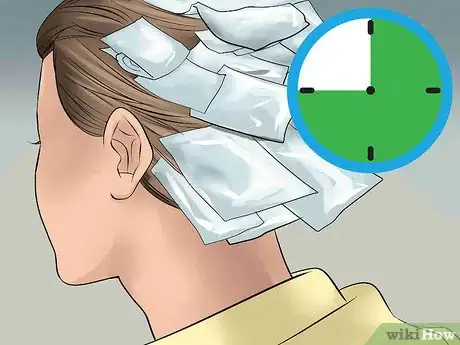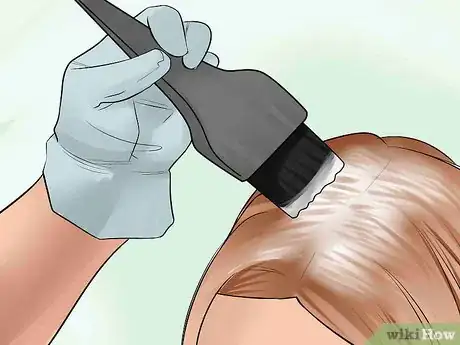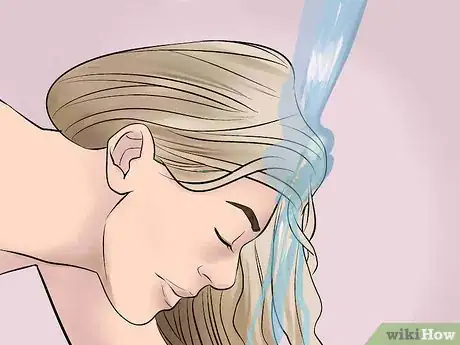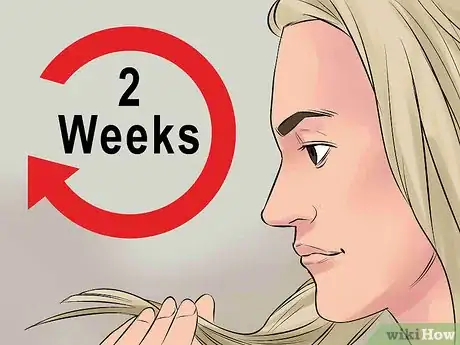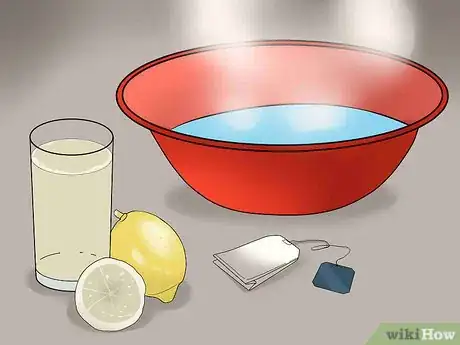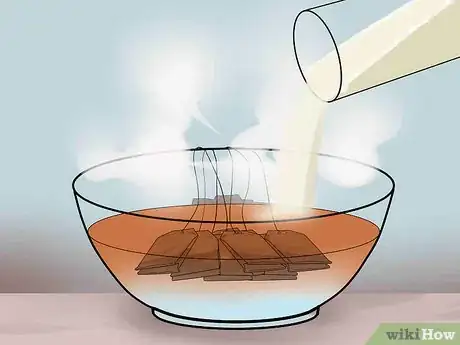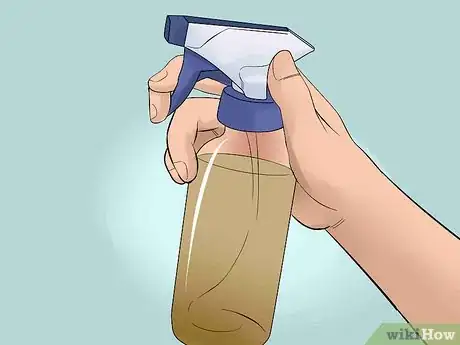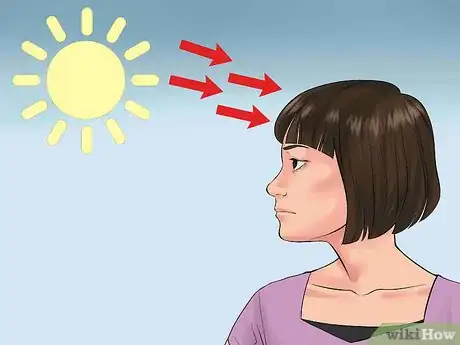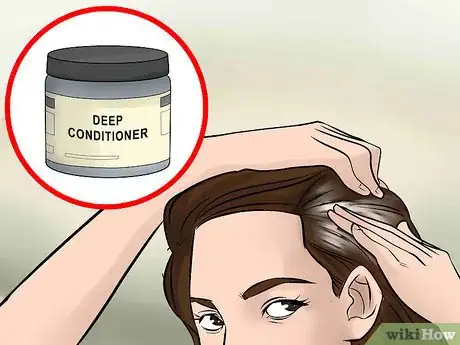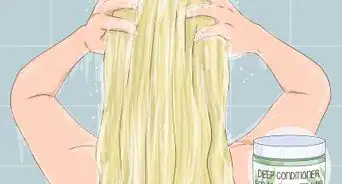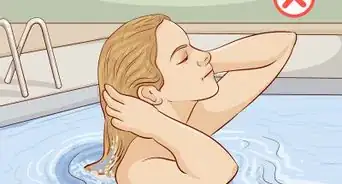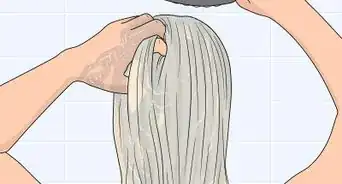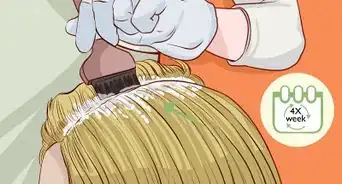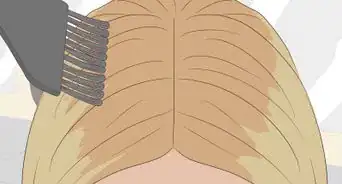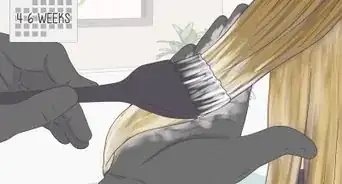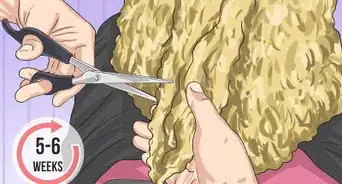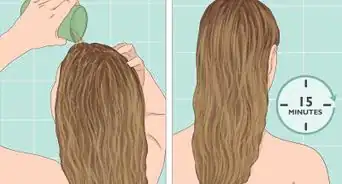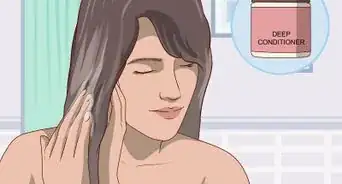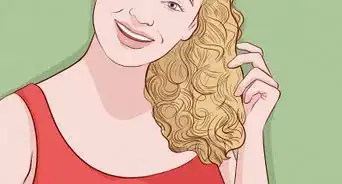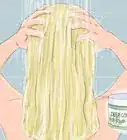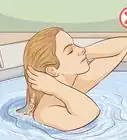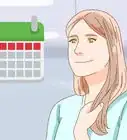This article was co-authored by Karen Leight. Karen Leight is a Professional Hair Stylist and the Owner of Karen Renee Hair, a private salon suite inside the Salon Republic Hollywood in Los Angeles, California. With over 12 years of experience, Karen is a licensed cosmetologist specializing in hair color, balayage technique, and women’s and men’s precision haircuts.
There are 7 references cited in this article, which can be found at the bottom of the page.
This article has been viewed 451,581 times.
Going from a dark brunette to blonde is a drastic change, but also one that’s fun and definitely doable. Whether you’re getting bored of your current look or just want to try a new style, going blonde will help to mix things up and give you an exciting new look.
Steps
Understanding the Process
-
1Use multiple treatments to reduce damage. If you are going from a dark color to a very light blonde, you can expect to do multiple treatments on your hair. Wait a few weeks between each treatment so that your hair has time to recover. Doing multiple treatments in one day will damage your hair. If you bleach your hair too often it can begin to fall out.[1]
-
2Expect some level of damage. Whenever you bleach your hair, an oxidation process is taking place, which removes the color from your hair. This is what leaves your hair a white or yellow shade, because the keratin (the protein your hair is made of) in your hair is naturally a pale yellow. Be prepared for your hair to suffer from dryness and brittleness as well as the fact that it will be more prone to breakage and split ends.[2]
- Because bleaching your hair is a serious process that can greatly damage your hair if done incorrectly, it is best to visit a professional if you are looking for a drastic color change.
- If you don't want to bleach your hair, you can use temporary color, demi-permanent, semi-permanent, or permanent color. These types of coloring only lightens your hair, so if you have very dark hair, it may not be very effective. However, the benefit of dyeing your hair versus bleaching it is that the dye won't strip your hair of color. It will still damage your hair somewhat, though, so you'll still need to take care of your hair in the same way that you would had you bleached it.
Advertisement -
3Be prepared for an orange tinted hair color during the process. If you are going from a very dark shade to a very light blonde, the process takes some time and during that time your hair will usually begin to develop an orangey tint. This happens because as you bleach your hair, cooler tones are lifted from your hair easier than the warmer, underlying pigments. So, as you remove color from your hair, the warm hues (reds and oranges) are what remain because they are trickier to lift from your hair.
- To counteract these warm hues you can add toner to your hair if you are going a very light blonde. This will counteract the remaining color in your air, thus removing those orangey, yellow tints in your hair. You can find the appropriate toner by looking at a toner wheel or asking a professional.
-
4Take great care of your hair. Anytime you bleach your hair it is important to take care of it to prevent further damage. Before you bleach your hair, apply a deep conditioner, and after you bleach your hair apply deep conditioner again. Also, try to avoid using heating products, as the heat from these can further dry out your hair and make it more prone to breakage.[3]
- If you must use your flat iron, blow dryer, or curling iron, make sure to use a heat styling product that will protect your hair from excessive heat.
Becoming a Blonde with Bleach
-
1Pre-condition your hair. Before you bleach your hair you should apply a deep conditioner to help protect it and keep it as healthy as possible. Bleach will greatly dry out your hair, so adding as much moisture to your hair as possible before you bleach it is an important step. That added moisture will lessen the damaging effects of the bleach.[4]
- Wash your hair a few days before you bleach it, but try to hold off until after you bleach it to wash it again. Bleaching freshly washed hair can irritate your scalp, so it's best to bleach hair that has more natural oils in it.
- You can use a few tablespoons of olive oil or coconut oil as an alternative to deep conditioner. These products will still condition your hair, giving it the moisture it needs.
-
2Gather ingredients and prepare your area. Put on an old t-shirt or towel to prevent bleaching your clothes and gather the ingredients and tools you will need: a small bucket or a color bowl to mix the bleach, a tint brush, and rubber gloves.
-
3Mix bleach with a developer. You can purchase bleach for your hair at a local drugstore or cosmetics store. You'll also need to buy some developer, which helps to lift hair color quickly. Follow the directions on the label to mix the bleach and developer together.[5]
- The higher volume of developer will lift more levels of color out of your hair. A lower volume developer will lift less levels of color out of your hair, leaving it a darker shade after you have finished bleaching it. If you want to take it easy and bleach your hair slowly, it's best to use a lower volume developer. Salons usually use a 20-volume developer.
- A bleach and developer mixture is what salons typically use to bleach hair. You can definitely a purchase a boxed-dye mix, but you can't customize it to suit the needs of your hair. It's beneficial to buy the items separately. The cost will be about the same and you'll have better luck protecting your hair.[6]
-
4Test a strand of hair. Some people have allergic reactions to certain hair products, so you'll need to test a portion of your hair to make sure the bleach doesn't harm you. Take the mixture and using a toner brush, apply to a one to two inch strand of hair on the bottom layer of your hair at the back of your head. Leave the mixture on for 30 to 45 minutes and then rinse it out.
- If you haven't experienced any reaction to the bleach you can proceed to bleach your hair.
-
5Section your hair into four parts. To achieve the best coverage and even bleach on your hair, separate it into four sections. Part your hair down the middle of your head or along your part, and then part your hair horizontally across your head. Then pull the front sections of hair around your face away from the rest of your hair. You can then clip your hair up to get it out of the way.
-
6Apply the mixture evenly through your hair. Start at the back sections of your hair, because they don't absorb bleach as well as the top so they will need more time to sit. Gather a piece of hair about a quarter inch thick and separate it from the rest of your hair. Then, use a tint brush to apply the bleach mixture, covering the roots last because the roots tend to process faster than the rest of your hair. Make sure you have evenly saturated the hair.
- Be careful not to get the bleach on part of your body or on your scalp as this can irritate your skin and cause a burning sensation. Make sure when you bleach the roots that you lift your hair up from your head so that you avoid brushing the bleach onto your scalp.
-
7Wrap your hair in foil. After you have applied your bleach to several sections of your hair, take a piece of foil about five to six inches wide and lay some of your bleached hair on top of it. Then, fold the foil up so that your hair isn't exposed.
- You don't have to use the foiling technique, but it can be helpful because it keeps the rest of your hair away from the hair that you have already bleached or if you're doing highlights and want to keep the bleach off of the rest of your hair.
- If you feel the foiling method may be too tedious, try using a plastic cap. It's much easier on your scalp since the foils can get heavy and it'll be easier to see how well the bleach lifts your hair.
-
8Let your hair sit for 30 to 45 minutes. Once you have covered all of your hair with bleach, let the mixture sit for about 30 minutes. Check it often to ensure it is lightening to the right degree. You may need more or less time, depending on how well your hair takes to the bleach. Then rinse your hair out with water and apply a purple shampoo. Let the shampoo sit for the amount of time recommended on the label, and then rinse it out.[7]
- To prevent any extreme hair damage, every 10 minutes, perform a pull test. You can do this easily by simply pulling gently on a few strands of hair from different sections. If any significant amount of hair breaks off or looks and feels "gooey" (it's probably fried), rinse the bleach out of your hair immediately and wash with a gentle shampoo and condition. You'll need to seek professional help from a colorist. Be sure to do your research before coloring your hair yourself!
- Because your brown hair has naturally warm hues, it will likely have a brassy color after you've bleached it. Purple shampoo helps remove the brassy color and neutralize yellow undertones. If you plan to use toner you don't have to use purple shampoo, but it does help remove those awkward tints to your hair. You can find this shampoo in the shampoo or hair dye section of your local drug or cosmetic store. You can also likely find purple shampoo in the brands John Frieda and Clairol Professional in your local grocery store.[8]
- If you chose not to use foil, make sure you cover your head with a shower cap, or something else that will prevent it from being exposed to the air -- you don't want your bleach to dry out.
-
9Apply toner to your hair. If you are happy with the color of your hair, you can proceed to condition it. However, if you want to remove even more brassiness, you can apply a toner to your hair. Towel dry your hair and comb it out with a wide tooth comb. Then, mix your toner with a 20-volume developer and apply evenly in your hair. Cover your hair again and let the toner sit for twenty to thirty minutes.
- To find the appropriate toner you can look at a toner wheel. On the wheel find the color that most matches the hues in your hair, and then purchase a toner in the color that is on the exact opposite side of the toner wheel.
- The amount of toner you mix with the developer will depend upon the type of toner you buy. Consult the directions for that specific toner before mixing it together.
- Make sure that you don't condition your hair before you apply the toner as that will make it more difficult for the toner to stick to your hair.
- If you plan to bleach your hair another time, wait to apply the toner until the last time you have bleached your hair.
-
10Rinse out the toner and apply conditioner. Once the toner has set, rinse it out with water and apply a deep conditioner. This has been stated several times but it's very important to do this to protect the health of your hair. You can also apply hair conditioning masks to provide even more moisture to your hair.
-
11Repeat this process two weeks later. If you want to go a lighter shade with your bleach, you can repeat this entire bleaching process a second and third time. Make sure that you wait at least two weeks between each bleach so that your hair has time to recover. Then, apply the bleach in the same way and condition to moisturize your hair inbetween each treatment to keep it healthy.[9]
Using Sun Activated Ingredients
-
1Gather your ingredients. To bleach hair naturally, meaning the sun will be what activates the blonde in your hair, you will need lemon juice, chamomile tea (or tea bags) and hot water. This process will take a much longer time and can be used to bring out the natural highlights in your hair, but most likely won't bring you to a platinum blonde color.
-
2Boil water and allow tea to steep. Steep five to ten chamomile tea bags for a few minutes in about half a liter (or two cups) of hot water in a microwave-safe glass measuring cup. Then, add about one half cup of lemon juice to your tea, pouring it into your solution until it becomes somewhat cloudy.[10]
- The amount of lemon juice you'll need to use varies, so start with half a cup and pour it into your tea for a few seconds, stopping when your tea becomes a cloudy mixture.
-
3Pour mixture into a spray bottle. After you have combined the ingredients, you'll want to pour the entire mixture into a spray bottle so that you can apply it to your hair. Then, spray throughout your hair for an even coating. Your hair should be damp with the solution but not soaking wet.
-
4Sit out in the sun. For the bleaching agents in the lemon juice to work, it will need to be exposed to the sun for a while. Stay outside in the sun until your hair dries, making sure to use sunscreen on the rest of your body to avoid damaging your skin. For the best results, leave the mixture on your hair for one to two hours.[11]
- This method works slowly, gradually bringing out the highlights in your hair, so know that it may take several weeks, spraying your hair daily or every other day, before your hair really becomes blonde, especially if you have very dark brown hair.
-
5Apply conditioner to your hair. Anytime you lighten your hair, even with natural products, you should protect it and keep it moisturized by applying a conditioner. You can use a leave in conditioner or coconut oil.
Expert Q&A
Did you know you can get expert answers for this article?
Unlock expert answers by supporting wikiHow
-
QuestionHow do I know what shade of blonde to dye my hair?
 Karen LeightKaren Leight is a Professional Hair Stylist and the Owner of Karen Renee Hair, a private salon suite inside the Salon Republic Hollywood in Los Angeles, California. With over 12 years of experience, Karen is a licensed cosmetologist specializing in hair color, balayage technique, and women’s and men’s precision haircuts.
Karen LeightKaren Leight is a Professional Hair Stylist and the Owner of Karen Renee Hair, a private salon suite inside the Salon Republic Hollywood in Los Angeles, California. With over 12 years of experience, Karen is a licensed cosmetologist specializing in hair color, balayage technique, and women’s and men’s precision haircuts.
Professional Hair Stylist
-
QuestionCan you lighten your hair with box color?
 Laura MartinLaura Martin is a Licensed Cosmetologist in Georgia. She has been a hair stylist since 2007 and a cosmetology teacher since 2013.
Laura MartinLaura Martin is a Licensed Cosmetologist in Georgia. She has been a hair stylist since 2007 and a cosmetology teacher since 2013.
Licensed Cosmetologist
-
QuestionCan you get blonde hair without bleach?
 Laura MartinLaura Martin is a Licensed Cosmetologist in Georgia. She has been a hair stylist since 2007 and a cosmetology teacher since 2013.
Laura MartinLaura Martin is a Licensed Cosmetologist in Georgia. She has been a hair stylist since 2007 and a cosmetology teacher since 2013.
Licensed Cosmetologist
References
- ↑ http://www.refinery29.com/how-to-bleach-hair#slide-1
- ↑ http://www.philipkingsley.com/hair-guide/chemical-hair-processing-and-colouring/bleaching-your-hair/
- ↑ http://www.philipkingsley.com/hair-guide/chemical-hair-processing-and-colouring/bleaching-your-hair/
- ↑ http://www.refinery29.com/how-to-bleach-hair#slide-2
- ↑ http://www.refinery29.com/how-to-bleach-hair#slide-3
- ↑ http://www.thewonderforest.com/2015/06/my-guide-to-at-home-hair-dye-and-bleach.html
- ↑ http://www.thewonderforest.com/2015/06/my-guide-to-at-home-hair-dye-and-bleach.html
- ↑ http://www.today.com/style/purple-shampoo-why-it-works-blond-hair-more-t104820
- ↑ http://www.thewonderforest.com/2015/06/my-guide-to-at-home-hair-dye-and-bleach.html
About This Article
The best way to go from brunette to blonde is to do multiple bleach treatments over several weeks. For each treatment, first apply a deep conditioner to protect your hair. Then, mix your bleach with a 20-volume developer. Section your hair into 4 parts and brush your bleach mixture onto your hair, starting at the back sections and working from tip to root. Wrap sections of your hair in 6 inch pieces of foil and wait 30-45 minutes before washing with a purple shampoo and a deep conditioner. For more tips from our Beauty reviewer, including how to become blonde using the sun, read on!
